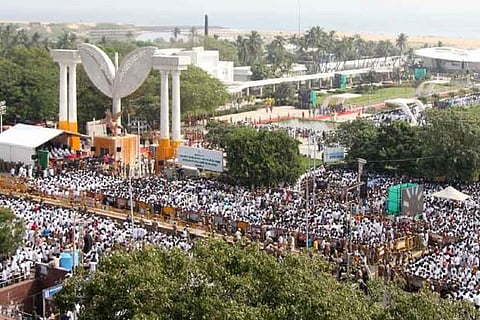

Chennai
The inauguration of the J Jayalalithaa Memorial adds one more structure to the state government’s already burgeoning inventory of buildings that require maintenance, upkeep and a plan to become a feasible source of revenue. Tamil Nadu, or more specifically Chennai, is home to the second-largest repository of heritage buildings in the country, trailing Kolkata which leads the pack. Within its metropolitan area itself, Chennai houses as many as 2,467 heritage buildings with many of these structures being as old as 200 years or more. However, several colonial-era structures built during the British Raj are now languishing for attention as decades of neglect have robbed these buildings of their once glorious facades.
It may be recalled that back in 2010, the Chennai Metropolitan Development Authority (CMDA) had been notified by a committee headed by Justice E Padmanabhan, who had listed out as many as 467 buildings in the city, including privately owned structures, as protected monuments in its report. The study aimed at giving heritage conservation a leg-up said that of these structures, 85 are government buildings in Chennai, which include 53 controlled by the Heritage Wing of the PWD. The rest fall under the purview of various government departments, both State and Central, which includes the Postal Department, Tangedco, etc.
Outside of Chennai, there are about 120 heritage buildings in the Coimbatore-Salem region, 40 in Tiruchy, and 60 in Madurai that falls under the Heritage wing of the state government. Two years ago, stakeholders in the government had drawn the public’s attention to its plans for immediate restoration of 10 buildings each in the Madurai and Tiruchy regions. However, the work was affected due to a shortage of staff and lack of trained resources. Not only has the wing been working at 25 per cent of its actual strength, but the allocation of resources, both financial and manpower-based, has also been a pain point as far as heritage structures in TN are concerned. Many such restorations require craftsmen with knowledge of ancient construction techniques, a tall order in itself.
There’s also been criticism that the Heritage Conservation Committee of the CMDA and the Chennai Corporation lack the appreciation and ability to restore and nurture buildings that need special attention. A case in point is the headquarters of Binny Ltd on Armenian Street in Parrys. The 200-year-old heritage building was razed in 2017, after being gutted by a fire and declared unfit for occupancy. CMDA had previously graded the Binny Limited building as a Grade II heritage structure. Similarly, a 175-year-old heritage structure housed within the premises of the government maternity hospital in Egmore was ordered to be demolished, keeping in mind the safety of the patients. Such buildings are essentially local landmarks, known for their architectural or aesthetic quality and significantly contribute to a city or state’s status and identity.
Of course, things are looking up. In a welcome move, the Public Works Department of TN had announced last December it would renovate as many as 29 heritage structures across the state, in one go. TN has set aside a sum of Rs 80 cr to restore buildings such as the Govt Printing Press in Chennai, and district collectorates in Cuddalore, Madurai and Pudukkottai. There’s so much more that can be accomplished on the heritage front if citizens also play an active role. Heritage walks and the like are typically initiatives by citizen groups or historians. The government could consider taking such activities under its wing as an extension of the tourism department. Awareness programmes about heritage buildings and their history at the school and college level would help the youth appreciate their city much more. Stakeholders in the civilian space, educators and activists must join hands when dealing with heritage structures. It might probably be one of the few tangible cultural links that bind one generation to the next.
Visit news.dtnext.in to explore our interactive epaper!
Download the DT Next app for more exciting features!
Click here for iOS
Click here for Android